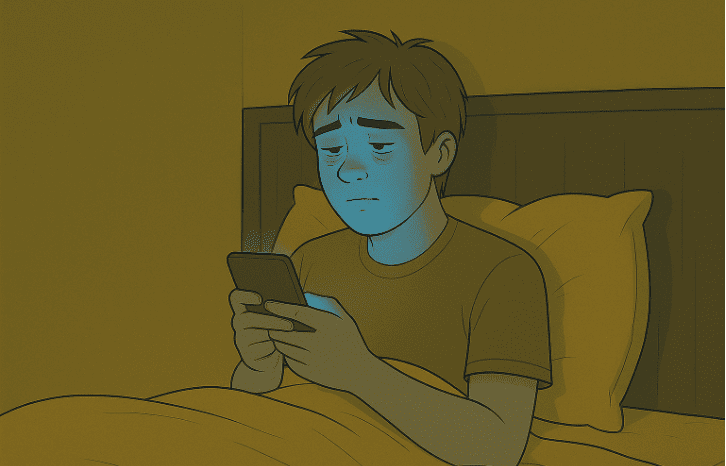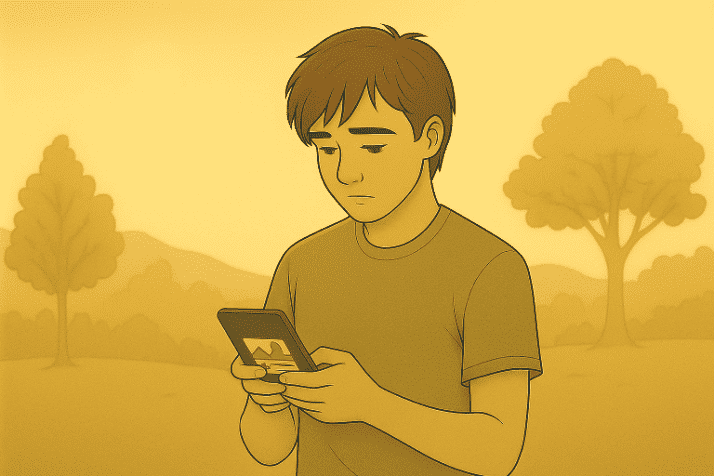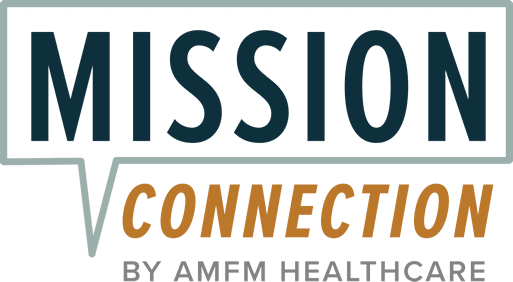
Key Takeaways
- Continuous social media use fragments your attention, overstimulates the brain, and causes digital fatigue; taking breaks restores clarity, memory, and healthier mental functioning.
- Notifications and unpredictable rewards create compulsive checking; pausing or limiting alerts interrupts this dopamine loop and helps form healthier habits.
- Anxiety, poor sleep, compulsive comparison, neglected relationships, and reduced focus are key signs it’s time for a social media break.
- Structured detox plans, digital boundaries, and mindful reintroduction of platforms build sustainable habits and support intentional, purposeful use.
- Mission Connection offers flexible, comprehensive mental healthcare, including therapy, psychiatric support, and life-skills training, helping adults and young adults regain balance, manage stress, and build lasting skills for healthier relationships with technology.
Why Your Brain Craves a Social Media Break Right Now
Your brain wasn’t designed for nonstop social media stimulation. Likes, comments, and notifications trigger dopamine, the same chemical linked to pleasure and addiction, creating a feedback loop that keeps you scrolling.
The average person checks their phone 96 times a day, fragmenting attention and preventing mental downtime. Without breaks, your brain struggles to process information, consolidate memories, and make meaningful connections, leading to digital fatigue. Social media breaks allow neural pathways to reset and restore clarity.
The Dopamine Loop That Keeps You Scrolling
Notifications act like slot machines, providing unpredictable rewards that reinforce checking. Over time, even anticipating alerts triggers dopamine, making phone use automatic. A break interrupts this loop, letting your brain form healthier responses to boredom and social triggers.
5 Signs You Need a Break
- Feeling anxious or “empty” without checking social media
- Constantly comparing yourself to others online
- Poor sleep from late-night scrolling
- Neglecting real-life relationships for digital ones
- Decreased productivity and focus
How Notifications Hijack Attention
Even unseen alerts fragment focus, causing a “task-switching penalty.” It takes some time to regain concentration after an interruption. Constant notifications train your brain to anticipate distractions, exhausting mental energy. Controlling alerts lets you decide availability rather than the algorithms.
Mission Connection offers flexible outpatient care for adults needing more than weekly therapy. Our in-person and telehealth programs include individual, group, and experiential therapy, along with psychiatric care and medication management.
We treat anxiety, depression, trauma, and bipolar disorder using evidence-based approaches like CBT, DBT, mindfulness, and trauma-focused therapies. Designed to fit into daily life, our services provide consistent support without requiring residential care.

Quick Start: 7-Day Social Media Detox Plan
A structured plan works better than vague intentions to “use social media less.” This 7-day guide offers gradual steps to help you ease into digital distance and build lasting habits, because real change happens progressively, not overnight.
Before You Begin
Spend 15 minutes noting your current habits: which platforms you use most, when you check them, and how you feel before and after scrolling. Take screenshots of your screen time reports to compare before and after the detox. This baseline awareness builds accountability and motivation.
Day 1–2: Notification Shutdown Protocol
Start by silencing all social media notifications and removing apps from your home screen. You’re not deleting accounts, just adding friction between impulse and action. Expect phantom vibrations or restlessness as your brain adjusts to less stimulation.
Prepare for this phase with healthy distractions: keep a book nearby, play an offline game, call a friend, start journaling, or take a walk. Physical movement is especially effective for resetting your mind and easing cravings.
Day 3–5: Replace Scroll Time with Real-World Activities
As discomfort fades, replace scrolling with activities that demand presence: cook, play music, or have an uninterrupted conversation. Notice how time stretches when you’re fully engaged, not endlessly scrolling.
Journal your observations and find hobbies or interests you once loved. These fulfilling replacements create positive momentum for maintaining digital balance.
Day 6–7: Mindful Reintroduction
Prepare for long-term balance by setting clear intentions. Decide which platforms genuinely add value and how much time you’ll allow each day.
When reintroducing social media, use it consciously: set a 10–15 minute timer and reflect afterward. Do you feel connected or drained? Energized or comparing? This awareness helps prevent slipping back into old, mindless patterns.
Your Digital Boundaries Toolkit
Setting effective digital boundaries takes both tech tools and personal discipline. Start with an honest audit of which platforms add value and which drain your energy. That clarity makes it easier to set realistic, purposeful limits rather than quitting social media altogether.
Digital boundaries work best when specific and measurable. Instead of saying, “I’ll use social media less,” try, “I’ll check Instagram once in the morning and once after dinner for 15 minutes.” Clear, trackable rules make boundaries stick.
Screen Time Limits That Work
Use built-in screen time tools on iOS or Android, but tailor them to your natural rhythms. Block social media during your first two hours after waking and the hour before bed to protect focus and rest.
Decide ahead of time what qualifies as a valid reason to override your limits to avoid guilt when slips happen. Track your consistency on a calendar as visual progress boosts motivation and accountability.
App Blockers That Reinforce Discipline
When willpower isn’t enough, use apps to create stronger guardrails. The best blockers work across devices and include features like focus sessions, scheduled downtime, and usage analytics.
For a low-tech option, use a timed lock box to keep your phone out of reach. Sometimes, physical barriers are the most effective.
Creating Phone-Free Zones
Designate spaces like the dining table and bedroom as device-free. These zones protect connection and rest while reducing blue light exposure. Set up charging stations outside these areas and add small reminders at entry points.
Encourage household participation, shared boundaries are easier to maintain, and modeling healthy tech use helps children develop better habits.
Setting Non-Negotiable Offline Hours
Choose daily windows, like the first and last hour of your day, to go fully offline. Use that time for activities that restore you: reading, meditation, or conversation.
These moments remind you that you control your technology, not the other way around. Over time, you’ll look forward to these quiet, grounded parts of your day.
Beat the FOMO: Mental Strategies That Work
Fear of missing out (FOMO) is one of the biggest barriers to taking real social media breaks. It’s not a personal weakness; platforms are designed to make you feel anxious about missing out on connections or information. Recognizing that FOMO is engineered helps you detach from it emotionally.
Research shows FOMO peaks when we’re stressed or feeling low, creating a loop where we seek comfort online but end up feeling worse. The truth is: while we fear missing out online, we’re often missing out on real life. Reminding yourself of that can help when the withdrawal feels strongest.
The 10-Minute Rule for Craving Control

When the urge to check social media hits, pause for 10 minutes. Do something else, stretch, make tea, or take a few deep breaths. Cravings usually fade within that window as your brain resets.
This works because it accepts the urge instead of fighting it. You’re not forbidding yourself, just delaying. Often, after ten minutes, the impulse is gone or much weaker.
Reframing Thoughts About Being Offline
Most FOMO anxiety comes from distorted thinking: “Everyone will forget about me,” or “I’ll miss something important.” Challenge these thoughts with facts. Has taking a short break ever actually harmed your relationships or opportunities?
Replace them with balanced alternatives like “My real friends understand my need for balance,” or “Important news will reach me anyway.” Write these reminders down to revisit when temptation strikes.
Shift focus from loss to gain, think, “I’m reclaiming time for what fulfills me,” instead of “I’m missing updates.” This mindset rewires scarcity into abundance.
Finding Fulfillment Beyond the Feed
The best way to beat FOMO is to find real-world satisfaction. Our brains thrive on face-to-face connection, movement, creativity, and time in nature, far richer rewards than digital validation.
Create a physical list (not on your phone) of things that genuinely make you feel good, from quick resets to longer offline activities. Choose sensory-rich options: cook, garden, paint, or walk outside. Engaging your senses grounds you in the moment and makes screen time feel less compelling.
Return Stronger: Smart Social Media Habits
A social media break means ultimately a return to using social media with intention and control. The goal is to shift from passive scrolling to purposeful use, leveraging social media’s benefits while minimizing its costs to your well-being. Achieving this balance requires both mindset shifts and practical strategies.
Define Your Purpose Before Returning
Before reengaging, clarify exactly what value you want from each platform, whether it’s maintaining friendships, networking, or staying informed. This clarity acts as your compass, helping you decide if your time online aligns with your goals.
Curate Your Content: Clean Up Your Feed
The simplest path to healthier social media use is curating your feed. Ask yourself: Does this account make me feel better or worse after I see its content? Unfollow or mute anything that fuels comparison or negativity.
Consider creating separate lists or secondary accounts for distinct purposes, like professional vs. personal or learning vs. entertainment. This compartmentalization promotes intentional engagement and helps prevent endless scrolling.
Be Purposeful, Not Passive
Before opening any app, finish this sentence: “I’m checking this platform right now to ___.” Maybe it’s to see a friend’s update or share something meaningful. Stating your intention keeps you focused and stops the automatic feed-hopping cycle.
If you struggle with impulse use, write your reason in a small notebook or sticky note. This moment of reflection helps separate conscious action from habit.
Do Weekly Digital Check-Ins
Healthy social media use isn’t a one-time fix. Set aside ten minutes each week to review your screen time and ask: Does my current use match my intentions? Make small adjustments before old patterns return.
These check-ins turn mindfulness into maintenance, helping you stay balanced, intentional, and in control long after your detox ends.
When Social Media Breaks Aren’t Enough
Sometimes, taking time off social media brings only temporary relief. If repeated breaks don’t lead to lasting change, it may signal deeper issues like anxiety, depression, or attention difficulties. In these cases, social media often acts as self-soothing rather than the root cause, intensifying existing emotional struggles.
If you experience severe withdrawal symptoms such as persistent anxiety, irritability, or inability to focus, or if you can’t stick to boundaries despite genuine effort, professional help may be needed. These signs suggest your relationship with social media has moved beyond your control.
When to Seek Professional Help
Digital addiction often mirrors other behavioral addictions: increased tolerance, withdrawal when offline, failed attempts to cut back, and continued use despite harm to work, relationships, or well-being. If your self-worth or mood depends heavily on online engagement, or social media has become your main coping mechanism, it’s time to seek specialized care.
Therapies such as cognitive-behavioral therapy (CBT), mindfulness-based approaches, and digital detox programs can help retrain thought patterns and build healthier habits.
Support Beyond the Screen: How Mission Connection Can Help

For some, social media breaks provide temporary relief but don’t address deeper challenges like anxiety, depression, or mood disorders. Mission Connection offers flexible, high-quality outpatient mental healthcare designed for adults and young adults, helping clients regain balance in daily life.
Our comprehensive approach blends therapy, psychiatric care, and life-skills support, delivered in formats that fit your lifestyle: in-person, virtual, or hybrid. This ensures access to professional care, if you have a busy schedule, live far from clinics, or prefer telehealth.
Key benefits of Mission Connection Care
- Personalized Therapy Plans: Individual, group, and experiential sessions specific to your needs.
- Licensed Professional Support: Evidence-based treatments including CBT, DBT, EMDR, EFT, and medication management.
- Flexible Access: In-person, virtual, or hybrid options for convenience across locations.
- Focus on Lasting Skills: Build tools to manage stress, set boundaries, and maintain mental wellness.
- Insurance & Billing Support: Assistance with most major plans to simplify access.
Clients at Mission Connection learn practical strategies to reduce stress, reclaim focus, and strengthen real-life connections, skills that directly support healthy relationships with technology and social media.
Take the next step toward lasting mental wellness. Speak with a specialist to verify insurance, take a brief assessment, and start a personalized care plan today.
Call Today 866-833-1822.
Frequently Asked Questions (FAQs)
How long should a social media break last to see benefits?
Even short 24–72 hour breaks improve mood and focus. Longer breaks of 7–14 days reset reward pathways and enhance sleep, while 2–4 weeks offer full clarity about social media’s role in your life.
Will I lose followers or connections if I take a break?
Temporary inactivity rarely affects followers or connections. Engagement may dip briefly as algorithms adjust, but personal relationships remain intact. Announcing your break often generates supportive responses rather than a loss of connections.
What should I do if my job requires social media use?
Use separate devices or browsers for work accounts, set strict time boundaries, batch tasks, or schedule posts. Discuss adjustments with supervisors, many will support breaks framed as productivity and wellbeing improvements.
Can I still use messaging apps while taking a social media break?
Maintain access to direct messaging for essential communication, but avoid feeds and algorithm-driven content. This keeps you connected without the comparison, distraction, and endless scrolling that social media typically encourages.
What if social media breaks aren’t helping me feel better?
Sometimes, breaks provide temporary relief but don’t address underlying issues like anxiety, depression, or mood disorders. Mission Connection offers flexible therapy programs, individual, group, and hybrid sessions, to help you build lasting coping skills.


